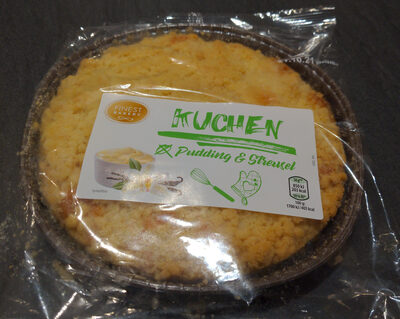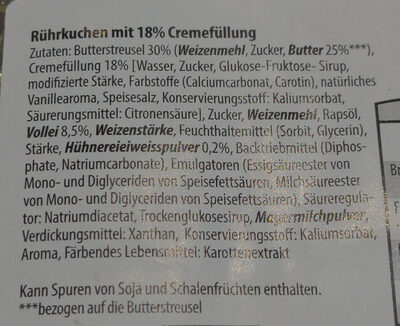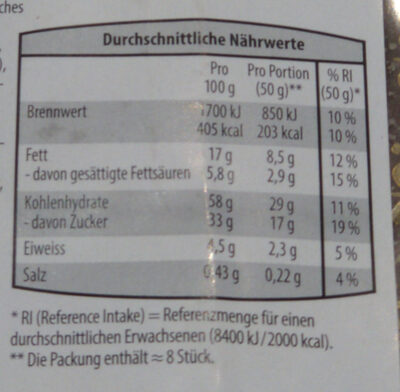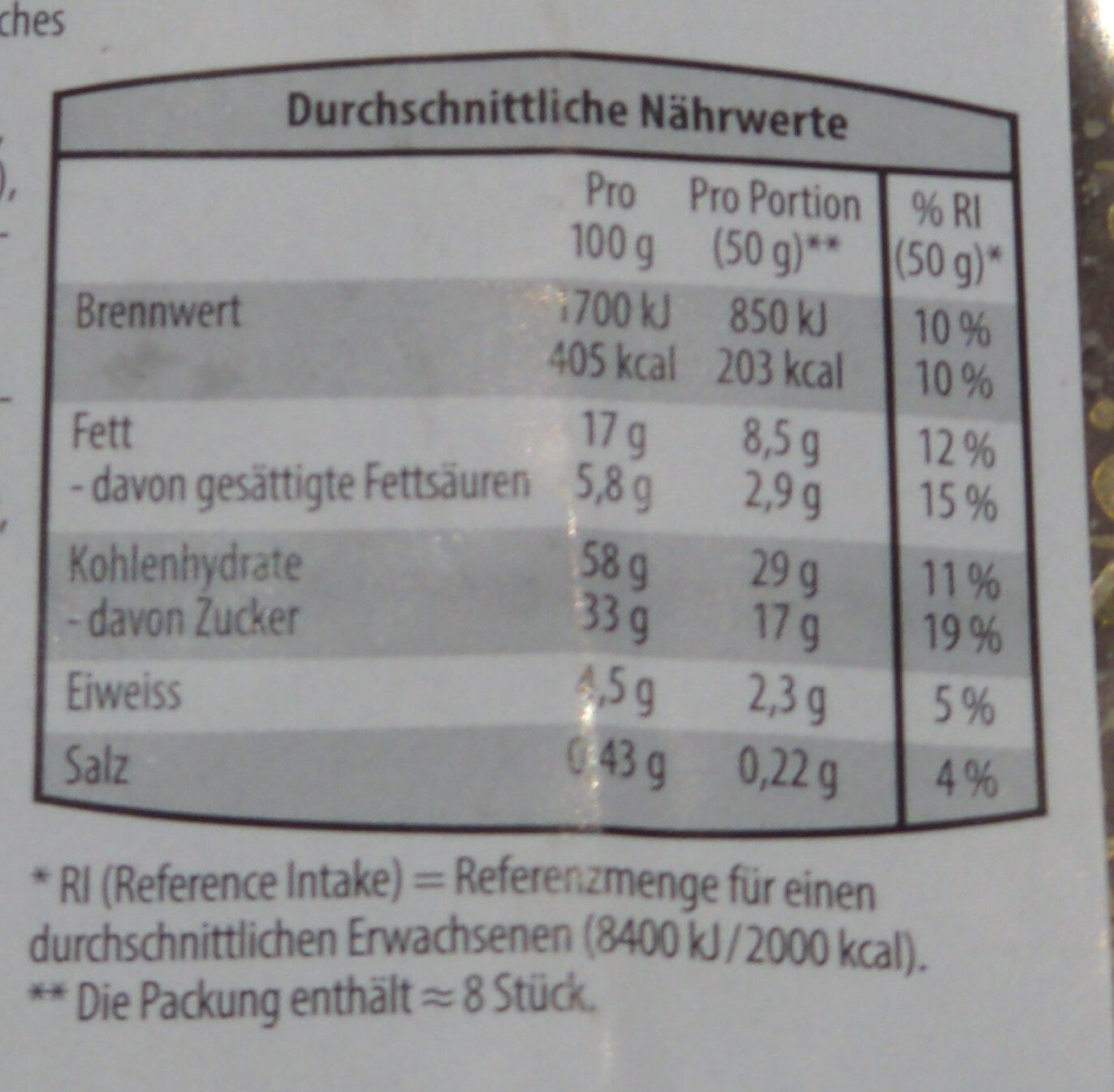Help us make food transparency the norm!
As a non-profit organization, we depend on your donations to continue informing consumers around the world about what they eat.
The food revolution starts with you!
Kuchen Pudding & Streusel - Hofer - 400g
Kuchen Pudding & Streusel - Hofer - 400g
This product page is not complete. You can help to complete it by editing it and adding more data from the photos we have, or by taking more photos using the app for Android or iPhone/iPad. Thank you!
×
Barcode: 4061459387391 (EAN / EAN-13)
Quantity: 400g
Packaging: Plastic
Brands: Hofer
Categories: Snacks, Desserts, Sweet snacks, Biscuits and cakes, Cakes, Pound Cake
Countries where sold: Austria
Matching with your preferences
Health
Ingredients
-
46 ingredients
: Butterstreusel 30% (Weizenmehl, Zucker, Butter 25%***), Cremefüllung 18% [Wasser, Zucker, Glukose-Fruktose-Sirup, modifizierte Stärke, Farbstoffe (Calciumcarbonat, Carotin), natürliches Vanillearoma, Speisesalz, Konservierungsstoff: Katiumsorbat, Säurerungsmittel: Citronensäure], Zucker, Weizenmehi, Rapsöl, Vollei 8,5%, Weizenstärke, Feuchthaltemittel (Sorbit, Glycerin), Stärke, Hühnereieiweisspulver 0,2%, Backtriebmittel (Diphos - phate, Natriumcarbonate), Emulgatoren (Essigsäureester von Mono - und Diglyceriden von Speisefettsäuren, Milchsäureester von Mono - und Digiyceriden von Speisefettsäuren), Säureregula - tor: Natriumdiacetat, Trockenglukosesirup, Memilchpulver, Verdickungsmittel: Xanthan, Konservierungsstoff: Kaliunsorbat, Aroma, Färbendes Lebensratel: Karottenextrakt Br Kann Spuren von Soja und Schalenfrüchten enthalten. ***bezogen auf die ButterstreuselAllergens: Eggs, Gluten, MilkTraces: Nuts, Soybeans
Food processing
-
Ultra processed foods
Elements that indicate the product is in the 4 - Ultra processed food and drink products group:
- Additive: E14XX - Modified Starch
- Additive: E160a - Carotene
- Additive: E170 - Calcium carbonates
- Additive: E415 - Xanthan gum
- Additive: E420 - Sorbitol
- Additive: E422 - Glycerol
- Additive: E472a - Acetic acid esters of mono- and diglycerides of fatty acids
- Ingredient: Colour
- Ingredient: Emulsifier
- Ingredient: Flavouring
- Ingredient: Glucose
- Ingredient: Glucose syrup
- Ingredient: Humectant
- Ingredient: Thickener
Food products are classified into 4 groups according to their degree of processing:
- Unprocessed or minimally processed foods
- Processed culinary ingredients
- Processed foods
- Ultra processed foods
The determination of the group is based on the category of the product and on the ingredients it contains.
Additives
-
E160a - Carotene
Carotene: The term carotene -also carotin, from the Latin carota, "carrot"- is used for many related unsaturated hydrocarbon substances having the formula C40Hx, which are synthesized by plants but in general cannot be made by animals -with the exception of some aphids and spider mites which acquired the synthesizing genes from fungi-. Carotenes are photosynthetic pigments important for photosynthesis. Carotenes contain no oxygen atoms. They absorb ultraviolet, violet, and blue light and scatter orange or red light, and -in low concentrations- yellow light. Carotenes are responsible for the orange colour of the carrot, for which this class of chemicals is named, and for the colours of many other fruits, vegetables and fungi -for example, sweet potatoes, chanterelle and orange cantaloupe melon-. Carotenes are also responsible for the orange -but not all of the yellow- colours in dry foliage. They also -in lower concentrations- impart the yellow coloration to milk-fat and butter. Omnivorous animal species which are relatively poor converters of coloured dietary carotenoids to colourless retinoids have yellowed-coloured body fat, as a result of the carotenoid retention from the vegetable portion of their diet. The typical yellow-coloured fat of humans and chickens is a result of fat storage of carotenes from their diets. Carotenes contribute to photosynthesis by transmitting the light energy they absorb to chlorophyll. They also protect plant tissues by helping to absorb the energy from singlet oxygen, an excited form of the oxygen molecule O2 which is formed during photosynthesis. β-Carotene is composed of two retinyl groups, and is broken down in the mucosa of the human small intestine by β-carotene 15‚15'-monooxygenase to retinal, a form of vitamin A. β-Carotene can be stored in the liver and body fat and converted to retinal as needed, thus making it a form of vitamin A for humans and some other mammals. The carotenes α-carotene and γ-carotene, due to their single retinyl group -β-ionone ring-, also have some vitamin A activity -though less than β-carotene-, as does the xanthophyll carotenoid β-cryptoxanthin. All other carotenoids, including lycopene, have no beta-ring and thus no vitamin A activity -although they may have antioxidant activity and thus biological activity in other ways-. Animal species differ greatly in their ability to convert retinyl -beta-ionone- containing carotenoids to retinals. Carnivores in general are poor converters of dietary ionone-containing carotenoids. Pure carnivores such as ferrets lack β-carotene 15‚15'-monooxygenase and cannot convert any carotenoids to retinals at all -resulting in carotenes not being a form of vitamin A for this species-; while cats can convert a trace of β-carotene to retinol, although the amount is totally insufficient for meeting their daily retinol needs.Source: Wikipedia
-
E170 - Calcium carbonates
Calcium carbonate: Calcium carbonate is a chemical compound with the formula CaCO3. It is a common substance found in rocks as the minerals calcite and aragonite -most notably as limestone, which is a type of sedimentary rock consisting mainly of calcite- and is the main component of pearls and the shells of marine organisms, snails, and eggs. Calcium carbonate is the active ingredient in agricultural lime and is created when calcium ions in hard water react with carbonate ions to create limescale. It is medicinally used as a calcium supplement or as an antacid, but excessive consumption can be hazardous.Source: Wikipedia
-
E262 - Sodium acetates
Sodium acetate: Sodium acetate, CH3COONa, also abbreviated NaOAc, is the sodium salt of acetic acid. This colorless deliquescent salt has a wide range of uses.Source: Wikipedia
-
E262ii - Sodium diacetate
Sodium acetate: Sodium acetate, CH3COONa, also abbreviated NaOAc, is the sodium salt of acetic acid. This colorless deliquescent salt has a wide range of uses.Source: Wikipedia
-
E330 - Citric acid
Citric acid is a natural organic acid found in citrus fruits such as lemons, oranges, and limes.
It is widely used in the food industry as a flavor enhancer, acidulant, and preservative due to its tart and refreshing taste.
Citric acid is safe for consumption when used in moderation and is considered a generally recognized as safe (GRAS) food additive by regulatory agencies worldwide.
-
E415 - Xanthan gum
Xanthan gum (E415) is a natural polysaccharide derived from fermented sugars, often used in the food industry as a thickening and stabilizing agent.
This versatile food additive enhances texture and prevents ingredient separation in a wide range of products, including salad dressings, sauces, and gluten-free baked goods.
It is considered safe for consumption even at high intake amounts.
-
E420 - Sorbitol
Sorbitol: Sorbitol --, less commonly known as glucitol --, is a sugar alcohol with a sweet taste which the human body metabolizes slowly. It can be obtained by reduction of glucose, which changes the aldehyde group to a hydroxyl group. Most sorbitol is made from corn syrup, but it is also found in nature, for example in apples, pears, peaches, and prunes. It is converted to fructose by sorbitol-6-phosphate 2-dehydrogenase. Sorbitol is an isomer of mannitol, another sugar alcohol; the two differ only in the orientation of the hydroxyl group on carbon 2. While similar, the two sugar alcohols have very different sources in nature, melting points, and uses.Source: Wikipedia
-
E422 - Glycerol
Glycerol: Glycerol -; also called glycerine or glycerin; see spelling differences- is a simple polyol compound. It is a colorless, odorless, viscous liquid that is sweet-tasting and non-toxic. The glycerol backbone is found in all lipids known as triglycerides. It is widely used in the food industry as a sweetener and humectant and in pharmaceutical formulations. Glycerol has three hydroxyl groups that are responsible for its solubility in water and its hygroscopic nature.Source: Wikipedia
-
E500 - Sodium carbonates
Sodium carbonates (E500) are compounds commonly used in food preparation as leavening agents, helping baked goods rise by releasing carbon dioxide when they interact with acids.
Often found in baking soda, they regulate the pH of food, preventing it from becoming too acidic or too alkaline. In the culinary world, sodium carbonates can also enhance the texture and structure of foods, such as noodles, by modifying the gluten network.
Generally recognized as safe, sodium carbonates are non-toxic when consumed in typical amounts found in food.
Ingredients analysis
-
May contain palm oil
Ingredients that may contain palm oil: E160a, E472a
-
Non-vegan
Non-vegan ingredients: Butter, Whole eggSome ingredients could not be recognized.
We need your help!
You can help us recognize more ingredients and better analyze the list of ingredients for this product and others:
- Edit this product page to correct spelling mistakes in the ingredients list, and/or to remove ingredients in other languages and sentences that are not related to the ingredients.
- Add new entries, synonyms or translations to our multilingual lists of ingredients, ingredient processing methods, and labels.
If you would like to help, join the #ingredients channel on our Slack discussion space and/or learn about ingredients analysis on our wiki. Thank you!
-
Vegetarian status unknown
Unrecognized ingredients: de:butterstreusel, de:cremefüllung, de:katiumsorbat, de:säurerungsmittel, de:weizenmehi, de:hühnereieiweisspulver, de:diphos, de:phate, de:milchsäureester-von-mono-und-digiyceriden-von-speisefettsäuren, de:säureregula, de:tor, de:memilchpulver, de:kaliunsorbat, de:bezogen-auf-die-butterstreuselSome ingredients could not be recognized.
We need your help!
You can help us recognize more ingredients and better analyze the list of ingredients for this product and others:
- Edit this product page to correct spelling mistakes in the ingredients list, and/or to remove ingredients in other languages and sentences that are not related to the ingredients.
- Add new entries, synonyms or translations to our multilingual lists of ingredients, ingredient processing methods, and labels.
If you would like to help, join the #ingredients channel on our Slack discussion space and/or learn about ingredients analysis on our wiki. Thank you!
-
Details of the analysis of the ingredients
We need your help!
Some ingredients could not be recognized.
We need your help!
You can help us recognize more ingredients and better analyze the list of ingredients for this product and others:
- Edit this product page to correct spelling mistakes in the ingredients list, and/or to remove ingredients in other languages and sentences that are not related to the ingredients.
- Add new entries, synonyms or translations to our multilingual lists of ingredients, ingredient processing methods, and labels.
If you would like to help, join the #ingredients channel on our Slack discussion space and/or learn about ingredients analysis on our wiki. Thank you!
: Butterstreusel 30% (Weizenmehl, Zucker, Butter 25%), Cremefüllung 18% (Wasser, Zucker, Glukose-Fruktose-Sirup, modifizierte Stärke, Farbstoffe (Calciumcarbonat, Carotin), natürliches Vanillearoma, Speisesalz, Konservierungsstoff (Katiumsorbat), Säurerungsmittel (Citronensäure)), Zucker, Weizenmehi, Rapsöl, Vollei 8.5%, Weizenstärke, Feuchthaltemittel (Sorbit, Glycerin), Stärke, Hühnereieiweisspulver 0.2%, Backtriebmittel (Diphos, phate, Natriumcarbonate), Emulgatoren (Essigsäureester von mono- und Diglyceriden von Speisefettsäuren, Milchsäureester von mono- und Digiyceriden von Speisefettsäuren), Säureregula, tor (Natriumdiacetat), glukosesirup, Memilchpulver, Verdickungsmittel (Xanthan), Konservierungsstoff (Kaliunsorbat), Aroma, bezogen auf die Butterstreusel- Butterstreusel -> de:butterstreusel - percent: 30
- Weizenmehl -> en:wheat-flour - vegan: yes - vegetarian: yes - ciqual_proxy_food_code: 9410
- Zucker -> en:sugar - vegan: yes - vegetarian: yes - ciqual_proxy_food_code: 31016
- Butter -> en:butter - vegan: no - vegetarian: yes - ciqual_proxy_food_code: 16400 - percent: 25
- Cremefüllung -> de:cremefüllung - percent: 18
- Wasser -> en:water - vegan: yes - vegetarian: yes - ciqual_food_code: 18066
- Zucker -> en:sugar - vegan: yes - vegetarian: yes - ciqual_proxy_food_code: 31016
- Glukose-Fruktose-Sirup -> en:glucose-fructose-syrup - vegan: yes - vegetarian: yes - ciqual_food_code: 31077
- modifizierte Stärke -> en:modified-starch - vegan: yes - vegetarian: yes - ciqual_proxy_food_code: 9510
- Farbstoffe -> en:colour
- Calciumcarbonat -> en:e170i - vegan: maybe - vegetarian: maybe
- Carotin -> en:e160a - vegan: maybe - vegetarian: maybe - from_palm_oil: maybe
- natürliches Vanillearoma -> en:natural-vanilla-flavouring - vegan: yes - vegetarian: yes
- Speisesalz -> en:salt - vegan: yes - vegetarian: yes - ciqual_food_code: 11058
- Konservierungsstoff -> en:preservative
- Katiumsorbat -> de:katiumsorbat
- Säurerungsmittel -> de:säurerungsmittel
- Citronensäure -> en:e330 - vegan: yes - vegetarian: yes
- Zucker -> en:sugar - vegan: yes - vegetarian: yes - ciqual_proxy_food_code: 31016
- Weizenmehi -> de:weizenmehi
- Rapsöl -> en:rapeseed-oil - vegan: yes - vegetarian: yes - from_palm_oil: no
- Vollei -> en:whole-egg - vegan: no - vegetarian: yes - ciqual_food_code: 22000 - percent: 8.5
- Weizenstärke -> en:wheat-starch - vegan: yes - vegetarian: yes - ciqual_proxy_food_code: 9510
- Feuchthaltemittel -> en:humectant
- Sorbit -> en:e420 - vegan: yes - vegetarian: yes
- Glycerin -> en:e422 - vegan: maybe - vegetarian: maybe
- Stärke -> en:starch - vegan: yes - vegetarian: yes - ciqual_proxy_food_code: 9510
- Hühnereieiweisspulver -> de:hühnereieiweisspulver - percent: 0.2
- Backtriebmittel -> en:raising-agent
- Diphos -> de:diphos
- phate -> de:phate
- Natriumcarbonate -> en:e500 - vegan: yes - vegetarian: yes
- Emulgatoren -> en:emulsifier
- Essigsäureester von mono- und Diglyceriden von Speisefettsäuren -> en:e472a - vegan: maybe - vegetarian: maybe - from_palm_oil: maybe
- Milchsäureester von mono- und Digiyceriden von Speisefettsäuren -> de:milchsäureester-von-mono-und-digiyceriden-von-speisefettsäuren
- Säureregula -> de:säureregula
- tor -> de:tor
- Natriumdiacetat -> en:e262ii - vegan: yes - vegetarian: yes
- glukosesirup -> en:glucose-syrup - vegan: yes - vegetarian: yes - ciqual_proxy_food_code: 31016
- Memilchpulver -> de:memilchpulver
- Verdickungsmittel -> en:thickener
- Xanthan -> en:e415 - vegan: yes - vegetarian: yes
- Konservierungsstoff -> en:preservative
- Kaliunsorbat -> de:kaliunsorbat
- Aroma -> en:flavouring - vegan: maybe - vegetarian: maybe
- bezogen auf die Butterstreusel -> de:bezogen-auf-die-butterstreusel
Nutrition
-
Missing data to compute the Nutri-Score
Missing nutrition facts
⚠ ️The nutrition facts of the product must be specified in order to compute the Nutri-Score.Could you add the information needed to compute the Nutri-Score? Add nutrition facts
-
Nutrient levels
-
Fat in moderate quantity (8.5%)
What you need to know- A high consumption of fat, especially saturated fats, can raise cholesterol, which increases the risk of heart diseases.
Recommendation: Limit the consumption of fat and saturated fat- Choose products with lower fat and saturated fat content.
-
Sugars in high quantity (17%)
What you need to know- A high consumption of sugar can cause weight gain and tooth decay. It also augments the risk of type 2 diabetes and cardio-vascular diseases.
Recommendation: Limit the consumption of sugar and sugary drinks- Sugary drinks (such as sodas, fruit beverages, and fruit juices and nectars) should be limited as much as possible (no more than 1 glass a day).
- Choose products with lower sugar content and reduce the consumption of products with added sugars.
-
Salt in low quantity (0.22%)
What you need to know- A high consumption of salt (or sodium) can cause raised blood pressure, which can increase the risk of heart disease and stroke.
- Many people who have high blood pressure do not know it, as there are often no symptoms.
- Most people consume too much salt (on average 9 to 12 grams per day), around twice the recommended maximum level of intake.
Recommendation: Limit the consumption of salt and salted food- Reduce the quantity of salt used when cooking, and don't salt again at the table.
- Limit the consumption of salty snacks and choose products with lower salt content.
-
-
Nutrition facts
Nutrition facts As sold
for 100 g / 100 mlAs sold
per serving (50g)Compared to: Pound Cake Fat 8.5 g 4.25 g -61% Saturated fat ? ? Carbohydrates 29 g 14.5 g -41% Sugars 17 g 8.5 g -38% Fiber ? ? Proteins 2.3 g 1.15 g -59% Salt 0.22 g 0.11 g -74% Fruits‚ vegetables‚ nuts and rapeseed‚ walnut and olive oils (estimate from ingredients list analysis) 6.5 % 6.5 %
Environment
-
Eco-Score C - Moderate environmental impact
⚠ ️Select a country in order to include the full impact of transportation.The Eco-Score is an experimental score that summarizes the environmental impacts of food products.→ The Eco-Score was initially developped for France and it is being extended to other European countries. The Eco-Score formula is subject to change as it is regularly improved to make it more precise and better suited to each country.Life cycle analysis
-
Average impact of products of the same category: C (Score: 59/100)
Category: Pound cake, prepacked
Category: Pound cake, prepacked
- PEF environmental score: 0.44 (the lower the score, the lower the impact)
- including impact on climate change: 3.69 kg CO2 eq/kg of product
Stage Impact Agriculture
82.3 %Processing
9.7 %Packaging
4.3 %Transportation
2.6 %Distribution
1.1 %Consumption
0.0 %
Bonuses and maluses
-
Missing origins of ingredients information
Malus: -5
⚠ ️ The origins of the ingredients of this product are not indicated.
If they are indicated on the packaging, you can modify the product sheet and add them.
If you are the manufacturer of this product, you can send us the information with our free platform for producers.
-
Packaging with a medium impact
Malus: -10
Shape Material Recycling Impact Unknown Plastic High ⚠ ️ The information about the packaging of this product is not sufficiently precise (exact shapes and materials of all components of the packaging).⚠ ️ For a more precise calculation of the Eco-Score, you can modify the product page and add them.
If you are the manufacturer of this product, you can send us the information with our free platform for producers.
Eco-Score for this product
-
Impact for this product: C (Score: 44/100)
Product: Kuchen Pudding & Streusel - Hofer - 400g
Life cycle analysis score: 59
Sum of bonuses and maluses: -15
Final score: 44/100
-
Carbon footprint
-
Equal to driving 1.9 km in a petrol car
369 g CO² per 100g of product
The carbon emission figure comes from ADEME's Agribalyse database, for the category: Pound cake, prepacked (Source: ADEME Agribalyse Database)
Stage Impact Agriculture
81.6 %Processing
6.4 %Packaging
7.8 %Transportation
3.7 %Distribution
0.5 %Consumption
0.0 %
Packaging
-
Packaging with a medium impact
-
Packaging parts
(Plastic)
-
Packaging materials
Material % Packaging weight Packaging weight per 100 g of product Plastic
-
Transportation
-
Origins of ingredients
Missing origins of ingredients information
⚠ ️ The origins of the ingredients of this product are not indicated.
If they are indicated on the packaging, you can modify the product sheet and add them.
If you are the manufacturer of this product, you can send us the information with our free platform for producers.Add the origins of ingredients for this product Add the origins of ingredients for this product
Report a problem
-
Incomplete or incorrect information?
Category, labels, ingredients, allergens, nutritional information, photos etc.
If the information does not match the information on the packaging, please complete or correct it. Open Food Facts is a collaborative database, and every contribution is useful for all.
Data sources
Product added on by tobias47n9e
Last edit of product page on by packbot.
Product page also edited by openfoodfacts-contributors.











